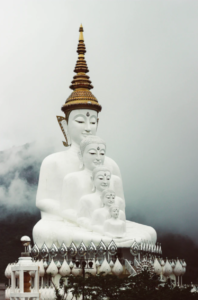Meditation and lucid dreaming share the same origin
 Typically, we think of meditation and lucid dreaming as two distinct practices. However, they both stem from the same origin: Tibetan Buddhist Dream Yoga. In this ancient tradition, both exercises were practiced together as one holistic discipline.
Typically, we think of meditation and lucid dreaming as two distinct practices. However, they both stem from the same origin: Tibetan Buddhist Dream Yoga. In this ancient tradition, both exercises were practiced together as one holistic discipline.
The practice was about stretching body and mind together to develop strength, endurance, and a healthier mind-body-spirit relationship. From a holistic perspective, the mind, body, and spirit are already connected. These exercises simply reinforced the connection.
Yoga in the waking state requires deliberate cooperation between body and mind. Yoga during the dream state involves very similar effortful cooperation but focuses more on the transcendent and spiritual aspects of the mind while the body rests in bed. But despite their differences, both types of yoga involve stretching, expanding, and strengthening the mind.
While Dream Yoga originated as a Buddhist practice, the Dalai Lama says, “Dream Yoga could be practiced by non-Buddhists as well as Buddhists.” – Andrew Holecek
Dream yoga is fascinating, and the lessons in Mind Awake involve some dream yoga practices and guided meditations. Please check out the app for more on that subject, but for now, let’s explore meditation from a more western perspective as it relates with lucid dreaming.
What exactly is meditation?
Think of meditation as a form of mental exercise. Just as physical exercises improve physical fitness, meditation improves mental fitness. Generally speaking, meditating involves using attention deliberately, focusing the mind in a specific, intentional, purposeful way.
Just like physical exercise, meditation takes conscious effort, practice, and persistence in order to yield desired results. You can learn more about how to practice meditation here, and why it’s a useful practice here.
The mind has many complex and puzzling aspects, ignorance of which can lead to unnecessary suffering. But as we learn to understand the mind, we see that exercise is helpful for the mind in similar  ways as it is helpful for the body.
ways as it is helpful for the body.
Meditation can help people acclimate and relate to the otherwise mysterious aspects of mind, simply by paying closer attention to them and becoming more conscious of them. This practice cultivates connection and fosters integration with the mind’s many, many parts.
And just as there are various ways to exercise physically, there are various ways to meditate.
Various types of meditation
Here are a few examples of different forms of meditation and different ways to practice. If you’re already a lucid dreamer, as you read the descriptions of these various meditation types, consider how they’d be useful for your lucid dream practice:
Transcendental meditation:
This is typically a spiritual practice in which meditators choose a mantra – a word or phrase which is repeated over and over, either silently or verbally. Mantras are used in other forms of meditation and can be applied to certain lucid dream techniques as well.
Body Scan meditation:
This exercise entails narrowing the scope of attention down to a point. For example, if you close your eyes and put all your attention into your right pointer finger, that would be the point of attention. Then attention moves sequentially through the body from one point to the next until the scan is complete.
There are many variations of this kind of meditation, and it can also be applied to some lucid dreaming practices which we’ll cover in this article.
Visualization meditation:
In nearly all meditative exercises, we have some sort of focal point or ‘anchor’ that holds our mind stable during the practice. For visualization meditations, that focal point is a mental image we create. This is quite like dreaming in itself, and it is great for applying to lucid dreaming practice in general. This is particularly useful during WILD which we discuss in this article as well.
Mindfulness meditation:
Practicing mindfulness involves paying close attention to the present moment as it is, without judgment. Mindfulness is often a combination of a few different guided meditation techniques merged into a more comprehensive practice. The subsequent Mindful meditations are often influenced by Vipassana (insight meditation), and more calming practices like breathwork and Samatha meditation.
Loving-kindness meditation:
This type of meditation promotes gratitude, empathy, and friendliness towards oneself and towards others. There is an emphasis on cultivating self-growth through love and genuine care. Loving-kindness mantras often go something like this:
-
- May I be happy and well
- May I be at ease
There are also other forms of meditation, many of which are variations of those mentioned above.
Why meditate for lucid dreaming?
Although both Lucid dreaming and meditating can be characterized as spiritual exercises, for simplicity, let’s stick with “exercise for the mind”.
Physical fitness requires skillful coordination, along with a sense of ease and familiarity in the body and mental fitness is quite comparable. Pairing meditation with lucid dreaming is a lot like pairing physical exercises like yoga, running, swimming, cycling, or weight-lifting. They all contribute in various ways to improve overall fitness and well-being.
 Now, although you cannot exercise physically in your sleep, you can exercise mentally without disrupting sleep.
Now, although you cannot exercise physically in your sleep, you can exercise mentally without disrupting sleep.
The waking state and the dreaming state are both manifestations of the same mind; they are two sides of the same coin. And you can exercise your mental coordination, flexibility, strength, endurance, and resilience during the day by meditating, and during sleep by lucid dreaming.
The waking life practices enhance the nighttime practices and vice versa. Both of these exercises can be great for improving mental health because it’s the same mind, just a different state of consciousness.
Which meditation is best for lucid dreaming?
After years of studying and practicing lucid dreaming, I’ve  found that there is no one-size-fits-all meditation for lucid dreaming. Generally, meditation is a great supporting exercise for lucid dreaming for a few reasons we’ll cover below. But I have found that some specific meditations can be applied to specific lucid dream induction techniques to make them more effective in real-time.
found that there is no one-size-fits-all meditation for lucid dreaming. Generally, meditation is a great supporting exercise for lucid dreaming for a few reasons we’ll cover below. But I have found that some specific meditations can be applied to specific lucid dream induction techniques to make them more effective in real-time.
The WILD (Wake Initiated Lucid Dreaming) method as outlined here, involves maintaining conscious awareness as you fall asleep so you can enter directly into a lucid dream. This means you must maintain vigilant concentration even as the rest of your mind and body fall asleep. As it turns out, certain meditation exercises are ideal for just this sort of concentration.
So, let’s look at which meditations work best for the WILD technique and why that is.
Meditations for WILD’ing
Whether it’s your first time, or you’re already experienced in practicing this technique, here are a few meditation exercises that can help with the WILD method:
Body Scan:
As you’re falling asleep, attempting to consciously transition into REM (rapid eye movement) sleep, you might try a body scan meditation. Sharpen your attention, and hone in on one specific focal point in your body. Then slowly and deliberately, move that focal point through your body. As you start to naturally fall asleep, hold onto that laser-focus, and notice the transition as your sleep cycle begins.
When you start to see hypnagogic imagery, try moving the point of focus from the body to the imagery as if it were an extension of your body. As sleep approaches, stay conscious in this way and you should enter the lucid state sooner or later.
Visualization:
This is a personal favorite lucid dream meditation practice for the WILD technique. Visualization meditation involves deliberately producing dream-like imagery before you’ve entered the dream state. Lie still in bed, get relaxed, calm, and present, and simply call an image to mind. Any image will do for a visualization meditation; it can be a person, place, object… whatever you like.
As you transition into sleep, focus attention on the details of the image. Let it get brighter and clearer as sleep approaches and eventually takes over.
Breathwork meditation:
Again, it’s all about the focal point. If you already use the breath as a point of focus during daytime meditation, you should try the same technique to induce a WILD. You’ll already be familiar with entering a meditative state by way of focusing on the breath, so use that familiar practice to help you maintain focus as you enter the lucid state.
Caveat: If you try the WILD technique and you enter dreamless deep sleep, you won’t enter into a lucid dream, so make sure to time it accordingly. Tips for how to time it here.
Meditating for longer lucid dreams
Meditation does not increase vivid dreams, improve dream recall, lucid dream induction, or lucid dream frequency. However, if you’re already able to get lucid, meditation can help you prolong that lucid awareness during the dream.
When the conscious and unconscious minds meet in the lucid state, it is easy to get distracted by the sheer astonishment and excitement of it all. And distraction is the enemy of lucidity. Maintaining lucidity depends on maintaining focus, attention, and awareness while in the lucid state.
Luckily, meditation sharpens mental focus, exercises attention span, and improves self-awareness. So by meditating while awake, you reinforce your ability to stay lucid in the dream state. Thus allowing you to truly explore the wonderful practice of Mindfulness-Based Lucid Dreaming.
